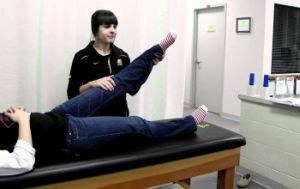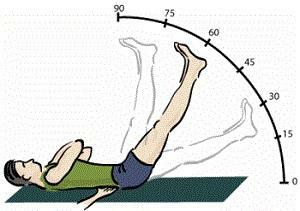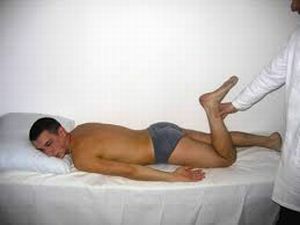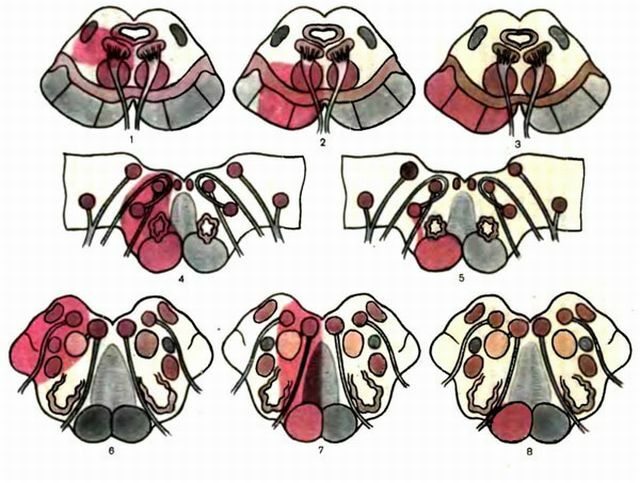 In response to exceeding the pain threshold, there is usually a muscle spasm, which can be exacerbated if there are problems with the spine and all supporting motor apparatus( for example, if osteochondrosis or arthritis is diagnosed).
In response to exceeding the pain threshold, there is usually a muscle spasm, which can be exacerbated if there are problems with the spine and all supporting motor apparatus( for example, if osteochondrosis or arthritis is diagnosed).
It is because of the infringement of the nerve roots due to osteochondrosis or another disease of the ODA that there is a muscle spasm that provokes the development of this or that tension symptom.
Importance of neurological diagnosis
As a rule, it is not an easy task to diagnose neurological diseases of the vertebral department in time and correctly, as often the symptoms of similar disorders are similar to other diseases, and with prolonged pain syndrome, pain can be perceived incorrectly by the brain. 
Almost all diseases of the spine cause spasms of muscles of different classes and degrees, as well as provoke the destruction of nerve roots and numeration of the injured limb.
In addition, quite often the symptom of tension can be an accompanying sign for osteochondrosis and other degenerative diseases.
There are several common tension syndromes in neurology and each of them is tested in a certain way.
Symptom Lasega
Almost always with vertebrogenic pain syndrome there is a muscle spasm that blocks the nerve roots, and this, as a rule, causes a symptom of Laceg's tension.
If the patient made sharp movements in the evaluation of Lasega's syndrome, then an additional examination for the presence of damaged nerve endings is necessary, since even the movement of the leg can break the fibers that connect the nerves to each other. Also, with a pinch of the sciatic nerve( he is the largest in the whole body), Lasega's bilateral syndrome can begin to develop.
Symptoms of Lasega:
- increase in pain syndrome when raising a damaged limb;

- ripple in the leg.
Definition and treatment:
- the doctor first determines the maximum angle of the leg lift;
- further, the leg is fully bent at the knee joint( with the pain disappear or decrease at times).
The doctor appoints a treatment complex consisting of therapeutic massage and other physiological procedures.
Symptom of planting
The planting syndrome allows to fully study the nature of the arisen pathological pains in the vertebral column and to find out the condition of the nerve roots. There is a similar diagnosis as follows:
- during the initial examination of the patient is asked to sit down and is in a semi-reclining position( with fully extended legs);
- if the patient has painful tension syndrome, then he will not be able to stay in this state for a long time because of exceeding the pain threshold and contraction of muscles in the knee joint area.
 An important way to diagnose tension is to palpate in a damaged area while the patient is sitting.
An important way to diagnose tension is to palpate in a damaged area while the patient is sitting.
The doctor probes possible areas of the lesion before receiving reflex spasms in the patient.
The planting syndrome is of great importance for the diagnosis of neurological diseases of peripheral nerves.
Tripod sign
When examining patients with complaints of vertebrogenic pain syndrome, practicing specialists carefully study the characteristic clinical signs of the disease, which allow distinguishing back pain caused by the damage to the nervous, bone and muscle tissues from the psychogenic pain sensations caused by the psycho-emotional state of a person.
One of the most specific signs that help distinguish the types of pain in the spine is the so-called tripod symptom.
When examining a patient with true pain in the spinal column, an experienced vertebrologist draws special attention to:
- the patient's position in the bed - he can only sit, leaning with both hands behind his back and not allowing movements;
- getting up from bed - the patient tries not to strain his back muscles as much as possible;
- position of the person on the chair - to reduce pain and unload the muscles, the patient tries to tilt the body back, leans on the hands.

Appearance of such a patient is quite typical, which is why this position of patients with true vertebral syndrome was called a tripod symptom. Very often such a sign is determined in people who underwent operative intervention on the spine with the installation of metal structures.
Other tension syndromes
Symptoms of tension also include:
- Bonnet reaction .If the patient can not reduce and dilute his leg with a preliminary neurological examination, this may mean that he has a symptom of Bonnet, which is characterized not only by an increase in the pain threshold, but also by the numbness of the limbs. Painful sensations are localized only in the damaged area.

- The Wasserman-Matskevich symptom .With a strong muscle tension, the patient may develop Wasserman and Mackiewicz syndromes. They are manifested with damage to the peripheral nervous system or nerves of the vertebral part.
- Neri symptom is manifested by stimulation of the posterior roots of the spinal cord, which develops due to osteochondrosis of the spine with bone osteophytes, disc hernias, root tumors, which leads to unpleasant pain sensations.
- Dejerine Syndrome is a symptom of tension, which is of a neurological nature and that is why when diagnosing a doctor, the attention is drawn to the smallest details. The pain is localized in the vertebral part and manifests itself only under physical stress. Is manifested due to the defeat of the column of the spinal cord.
Provoking diseases
If, after carrying out all the necessary diagnostic measures, this or that tension syndrome has been identified, this can indicate the first stages of the following diseases:
- Osteochondrosis of the spine is a fairly common disease that occurs due to pinching of nerves between the intervertebral discs. This clogging is characterized by numbness in the affected area, increased pain threshold and sweeping in the buttocks.
- Pinch of the sciatic nerve - painful sensations spread throughout the nerve( similar syndrome in the medical literature is called sciatica)
- Ankylosing spondylitis is characterized by pain and deposits of salt and calcium throughout the vertebral area.
- The sciatica of the lumbosacral spine is a pronounceda disease that manifests itself by such symptoms: the symptoms of tension of nerve roots, sacral syndrome( when lifting a healthy limb pain is given to it), nerve pincering and Neri syndrome, with
In order to prevent the development of severe pathologies, a timely diagnosis andIt can be done by a neuropathologist who, after carrying out special diagnostic measures, can identify a neurological disease.



